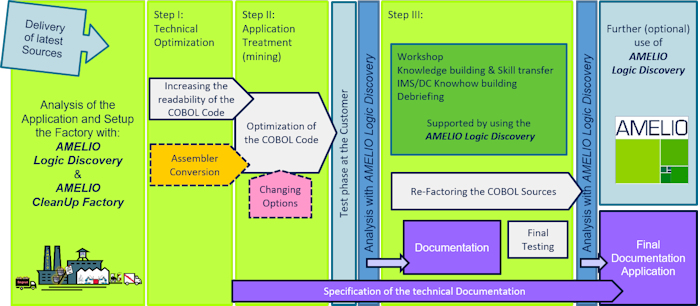A large insurer has renovated a key component of his core application with the solutions from Delta Software Technology (Delta). Delta's AMELIO-Tools for automated analyses, code clean-up and re-documentation ensure a future-proof application infrastructure and an easy know-how transfer to the application heirs.
In the 1980s the insurer's IT developed a COBOL application for the screen control. Until now this forms an important part of the application infrastructure. Since its initial development this part of the application and the entire application have evolved: Extensions have been added over and over again. The screen control has been maintained by several generations of developers. Different programming styles and COBOL versions have been used for the further development. Moreover, the screen control has been optimized according to former criteria. These criteria are no longer applicable. However, over time all of these measures have greatly affected understandability and maintainability.
The screen control has proven itself over the years. For this reason, it was decided to make this part of the established and reliable application fit for the future to preserve the proven application logic and to ensure the investments effected. The improvement of the application should be carried out safely and with as less effort as possible.
Fit for the future
For making the application fit, the following measures should be implemented:
- Clean-up and upgrade (refactoring) of the source code, so that it will be understandable and maintainable again and that changes and extensions can be implemented efficiently.
- Creating a technical documentation to better understand what the application does and how it works.
- Knowledge transfer about the application and its functionality to new developers.
A manual implementation of the measures would have been risky and inefficient:
- Efforts and risks could not be estimated.
- The daily business would have been disturbed due to a strong resource commitment.
- Massive testing efforts, to ensure the correctness of the changes.
The insurer has chosen the automated solution with Delta’s tools and was able to avoid the problems of a manual approach.
 Usage of the Delta AMELIO family
Usage of the Delta AMELIO family
To solve the task, Delta suggested a multi-level approach with the following elements:
- Code clean-up
- Replacement of VORELLE
- In-depth source analyses
- Refactoring
- Re-documentation
- Workshops for the knowledge transfer
Analysis and clean-up of the sources
During the first step, the AMELIO toolset was configured regarding the customer-specific programming styles, name conventions, etc. General clean-ups, like the removal of redundant code and the standardisation of syntax variants, were implemented by using the AMELIO CleanUp-Factory.
The analysis with AMELIO Logic Discovery identified what the application does and how it works. From these analysis results Delta derived suggestions for a tailor-made refactoring. These suggestions, as well as other requirements of the customer, were evaluated and coordinated in close cooperation to build the customer-specific factory.
With this tailor-made solution the refactoring was performed in an audit-proof way.
Workshop for the knowledge transfer
The results of the analyses and the refactoring were presented in a workshop and thus new employees were trained to work with the implementation of the screen control. Further possible improvements of the application were defined. The employees benefitted from the functionality of AMELIO Logic Discovery when implementing these improvements. They gained deep insight in the sources and were able to build their know-how about the application.
Final analysis and re-documentation
Finally, these sources were analysed again by AMELIO Logic Discovery and a documentation of the entire application was created automatically. With the help of this documentation and the interactive presentation in AMELIO Logic Discovery, first maintenance cases have been implemented quick and efficiently.

Highlights and benefits of the Delta solution
The clean-up and refactoring were performed by a factory specifically configured for this purpose:
- Automated - The changes were implemented automatically and without manual interventions. The strict process ensured that the results are always comprehensible and reproducible. In this way, efforts and risks of the project have been minimized.
- Audit-proof - All changes to the code have been documented automatically. The complete automation and the change log provide security for internal and external auditors.
- Tailor-made - The necessary code changes were agreed with the customer and adapted to his requirements and company policies.
- Documented - A documentation of the application was created automatically.
- Knowledge Building - The knowledge about the application and its functioning was regained.
- Without footprints, without vendor lock-in - No additional runtime components or new products have to be installed or licensed. In addition, third-party tools, such as the decision table generator VORELLE, could been removed.
- Short freeze phase - The development and maintenance of the application could be continued in parallel without hindrance.
- Minimal test effort - Using Meta-level testing, not all changed programs had to be tested, but only the change rules using a small test set.
Goal achieved …
The customer has managed to make his application fit for the future with little effort and low risk. With the gained experience it is now possible to decide how to make further (complex) applications fit for the future, while reusing the factory.
When will you make this step?
You have COBOL, PL/I or Delta ADS applications that have proven themselves and you want to make sure they are fit for the future?
Get in touch with us and find out what is possible with an automated approach.
Download Language: Englisch - Version: mt21089-1

A large insurer has renovated a key component of its core application with the solutions from Delta Software Technology. Deltas AMELIO-Tools for automated analyses, code
clean-up and re-documentation ensure a future-proof application infrastructure as an easy know-how transfer to the application heirs.
